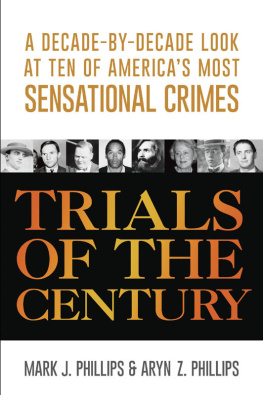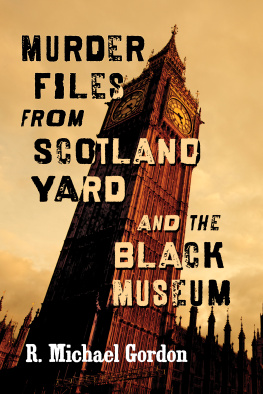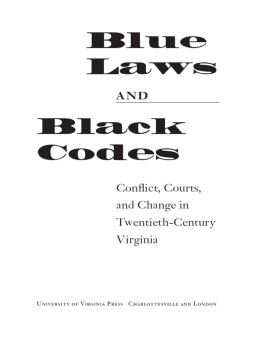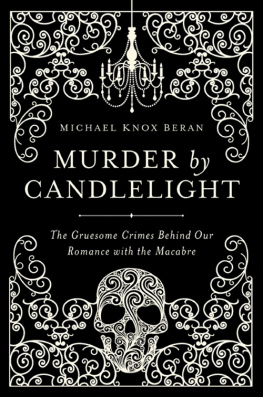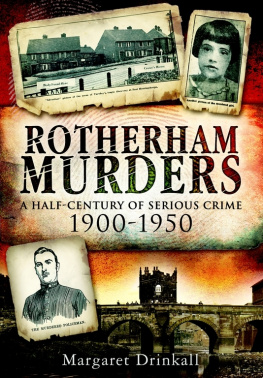2008 Michael Ayers Trotti
All rights reserved
Set in Monticello and Smokler types
by Tseng Information Systems, Inc.
Manufactured in the United States of America
The paper in this book meets the guidelines for permanence and
durability of the Committee on Production Guidelines for Book Longevity
of the Council on Library Resources.
Library of Congress Cataloging-in-Publication Data
Trotti, Michael Ayers.
The body in the reservoir : murder and sensationalism in the South /
by Michael Ayers Trotti.
p. cm.
Includes bibliographical references and index.
ISBN 978-0-8078-3178-6 (cloth : alk. paper)
ISBN 978-0-8078-5842-4 (pbk. : alk. paper)
1. Sensationalism in journalismVirginiaRichmondHistory
19th century. 2. Sensationalism in journalismVirginiaRichmond
History20th century. 3. MurderPress coverageVirginiaRichmond
History19th century. 4. MurderPress coverageVirginia
RichmondHistory20th century. I. Title.
PN4899.R54T76 2008
071.455451dc22 2007044720
Parts of chapter 4 were published in Jim Crow Justice, the Richmond Planet,
and the Murder of Lucy Pollard, in Murder on Trial, 16202002, ed. Robert Asher,
Lawrence B. Goodheart, and Alan Rogers (Albany: State University of New York Press,
2005). Parts of chapter 5 were published in Murder Made Real: The Visual Revolution
of the Halftone, Virginia Magazine of History and Biography 111, no. 4 (2003):
379410. Used with permission.
12 11 10 09 08 5 4 3 2 1
Figures
1. Engraving of Thomas Judson Cluverius, 1885
2. Engraving of Fannie Lillian Madison, 1885
3. Engravings of Cluverius and Madison, 1885
4. Photograph of Cluverius, 1885
5. Photograph of Madison, 1885
6. Engraving of William Dandridge Epes, 1849
7. Cover of pamphlet depicting Garcia and Castillano murder scene, 1821
8. Woodcut image of the Albert TirrellMaria Bickford murder, 1845
9. Melodramatic cover of Henry Delter fictional pamphlet, 1851
10. Benevolence found in facial features, 1869
11. Engraving depicting a menacing James Jeter Phillips, 1868
12. A more primitive engraving of Cluverius, 1885
13. Close-up of crossline screen within halftone image of Henry Clay Beattie Jr., 1911
14. Halftone montage of Beattie case, 1911
15. Halftones of Henry Beattie, 1911
16. Halftones of Beulah Binford, 1911
Acknowledgments
I have received scholarly, technical, financial, professional, and even emotional assistance at every turn in the road of this project. As much as it is my work, this book is also the product of the ferment I found among my colleagues in Chapel Hill and my colleagues in the Chapterhouse Beer and History writing group in Ithaca. The faults belong to me, but the book is much better than I could have made it due to the help I received from so many sources.
Fellowship support for this project came from the National Endowment for the Humanities (NEH), the Virginia Historical Society, the Mellon Foundation, Ithaca College (IC), and the history department and graduate school of the University of North Carolina at Chapel Hill. The State of North Carolina provided an institution of learning with tuition costs low enough to allow people without much in the way of means to receive a world-class education. The federal government helped with loan subsidies and Earned Income Tax Credits. Summer grant help from both Ithaca College and the NEH allowed me to utterly change and shift and revise the project into a book twice as meaningful as I first envisioned. These were significant financial contributions that all too often remain in the background. I thank everyone who made them available.
I have been blessed with a thoughtful, talented, and helpful array of friends, colleagues, and professors who inspired and pushed me. Jacquelyn Hall, Leon Fink, Peter Filene, and John Orth have helped me in more ways that I can count. They have read my work closely, offering advice on the project and on the profession. Leon Fink served as my advisor for a time, and Jacquelyn Hall became something like a second advisor and mentor to me. John Kasson was actively involved in my training from my first semester at Carolina, and he both inspired my work and helped to hone my skills in any number of ways. He was an ideal advisor. My debts to him and to these other Chapel Hill faculty are broad and deep. Thank you all.
The project has been transformed in the past few years; two writing groups and the support of the Ithaca College history department have been vital in that process. Thanks to the GTFTD writing group at Carolina: John Hepp, Robert Tinkler, Gary Frost, Stacy Braukman, Mike Ross, Tom Devine, Gavin Campbell, Molly Rozum, Steven Niven, Jonathan Young, and Eric Combest. This group met regularly for several years, and at one point or another, they read most of the manuscript. In Ithaca, the IC history department has been supportive of my scholarship in every way. The Chapterhouse Beer and History writing groupJefferson Cowie, Rob Vanderlan, Michael Smith, Aaron Sachs, Derek Chang, Adriane Lentz-Smith, Joel Dinerstein, Finis Dunaway, and Caroline Merithewoffers a scintillating mixture of good humor, good beer, and pointed, meaningful analysis. It is not an overstatement for me to say that without this group I would not have been able to write this book. Thank you; Ill start a tab.
The research for the project depended on a number of people who helped me gather together the primary materials so important to this study. The reference, interlibrary borrowing, and microfilm staffs at the University of North Carolina and the interlibrary borrowing personnel at Ithaca College have each facilitated my research. The librarians and archivists at the Virginia Historical Society, the Valentine Museum, and the Library of Virginia were all of tremendous help. Reviewers and editors at the Virginia Magazine of History and Biography (particularly Nelson Lankford) and at UNC Press (especially Chuck Grench, Katy OBrien, Paul Betz, and Leslie Watkins) were very helpful as well. Daniel Cohen, in particular, put such tremendous energy into his review of the manuscript that it is now a much better book. Although my first glance at his nineteen-page, single-spaced review brought a gasp, I quickly realized what a precious gift Id received. In the final stages of revision, Lauren Georger gave me an undergraduate history majors perspective on the entire book. Thank you all.
Life is much more than research and scholarship, even for a historian. Christine and I have been blessed with friends in both Chapel Hill and Ithaca who have helped sustain us. Jeff Cowie and Janis Whitlock, Robert Tinkler, and Rona Van Willigan all shared the house with us on McCauley Street in Chapel Hill. We have since found a wealth of friends who have made Ithaca home. My parents have provided tangible gifts that have eased the process of research, writing, and living throughout this project. Even more important, they have afforded meaningful support as my family. Thank you all for your love and friendship.
When I think of the sacrifices my wife has made as I have pursued this project, it becomes clear that despite all the help I have received from others, this work owes mostan incalculable debtto her. If the subject matter of the book were anything other than murder, mayhem, and, in particular, wife killings, I would surely dedicate it to you, Christine. As it is, I think not. Poor taste. You have helped me through health problems, low points, successes, years of fatigue, and a stray panic attack or two. Or three. In the course of this project, you and I have shared the most amazing gifts we will ever know. Sophia Rose has screamed, smiled, toddled, walked, and danced around us, followed by Sam, who is now dancing around us himself, putting the book (and the rest of life) into perspective. Thank you for everything.


